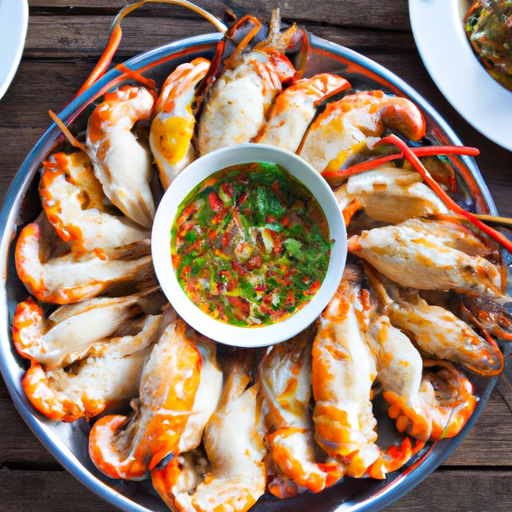Are you a food and wine enthusiast always on the lookout for new and exciting flavors? If so, have you ever considered trying Thai cuisine? With its unique blend of flavors, vibrant spices, and fresh ingredients, Thai food is a must-try for any self-proclaimed foodie. In this article, we will explore why Thai cuisine should be on your radar and how it can satisfy not only your taste buds but also your love for wine.
Thai cuisine is known for its bold and harmonious flavors that seamlessly blend sweet, sour, salty, and spicy elements. From the famous Pad Thai to the aromatic Green Curry, Thai dishes never fail to tantalize your palate. The secret lies in the skillful use of herbs and spices like lemongrass, galangal, chilies, and coriander, which create a symphony of flavors in every bite. Moreover, Thai food often incorporates fresh ingredients such as coconut milk, lime juice, and fish sauce, adding depth and complexity to the dishes.
But it’s not just the flavors that make Thai cuisine a must-try for food lovers. Thai food also pairs incredibly well with a variety of wines, making it a delightful experience for wine enthusiasts. The contrasting flavors and textures in Thai dishes provide a great opportunity for wine pairing. Whether it’s a crisp and acidic white wine to complement the spicy and tangy flavors or a fruity and aromatic red wine to balance the richness of coconut milk-based curries, Thai cuisine offers endless possibilities for wine lovers. So, if you’re looking to expand your culinary horizons and elevate your wine pairing skills, Thai cuisine should undoubtedly be on your list. Stay tuned to learn more about the best Thai dishes to enjoy with different types of wine.

Introduction to Thai Cuisine
If you consider yourself a food and wine enthusiast, then Thai cuisine is an absolute must-try. Bursting with vibrant flavors, aromatic spices, and a perfect blend of sweet, spicy, sour, and salty tastes, Thai dishes offer a unique culinary experience that will tantalize your taste buds and leave you craving for more.
The origins of Thai cuisine
Thai cuisine has a rich history that can be traced back to the ancient kingdoms of Sukhothai and Ayutthaya. Over the centuries, Thai cuisine has been influenced by neighboring countries such as China, India, and Malaysia, resulting in a fusion of flavors and techniques that make Thai dishes truly special.
Characteristics of Thai cuisine
One of the key characteristics of Thai cuisine is its emphasis on the balance of flavors. Thai dishes typically incorporate a combination of sweet, spicy, sour, and salty tastes, creating a harmonious blend that is both complex and delicious. The use of fresh herbs and spices is also a defining feature of Thai cuisine, adding depth and aroma to the dishes.
Traditional Thai ingredients
Traditional Thai cuisine relies heavily on fresh ingredients such as lemongrass, galangal, kaffir lime leaves, Thai basil, and cilantro. These herbs and spices add a distinct flavor profile to the dishes and contribute to the unique taste of Thai cuisine. Other common ingredients include coconut milk, fish sauce, shrimp paste, and tamarind paste, which provide a depth of flavor and richness to the dishes.
Popular Thai Dishes
When it comes to Thai cuisine, there are several dishes that have gained international popularity and have become favorites among food enthusiasts worldwide. Here are some of the most popular Thai dishes that you must try:
Pad Thai
Pad Thai is a staple dish in Thai cuisine and is a must-try for any foodie. This stir-fried noodle dish is made with rice noodles, tofu, shrimp or chicken, bean sprouts, peanuts, and a tangy tamarind sauce. The combination of flavors and textures in Pad Thai is what makes it so beloved by locals and foreigners alike.
Green Curry
Green Curry is a classic Thai dish known for its vibrant green color and spicy flavors. Made with green curry paste, coconut milk, chicken or beef, and a variety of vegetables, this curry is both aromatic and delicious. The heat from the curry paste is balanced perfectly by the richness of the coconut milk, creating a flavorful and satisfying dish.
Tom Yum Soup
Tom Yum Soup is a hot and sour soup that is a signature dish in Thai cuisine. Made with shrimp, mushrooms, lemongrass, kaffir lime leaves, and chili, this soup is bursting with bold and refreshing flavors. The combination of tangy lime juice, spicy chili, and fragrant herbs makes Tom Yum Soup a must-try for any food lover.
Massaman Curry
Massaman Curry is a unique Thai dish that showcases the Indian influence on Thai cuisine. Made with a blend of spices such as cardamom, cinnamon, and cloves, this curry is rich, aromatic, and slightly sweet. It is typically made with beef or chicken, potatoes, and peanuts, creating a hearty and flavorful dish.
Som Tum (Papaya Salad)
Som Tum, also known as Papaya Salad, is a refreshing and spicy dish that is a popular street food in Thailand. Made with shredded green papaya, tomatoes, peanuts, and a tangy dressing, this salad is a burst of flavors and textures. The combination of spicy, sweet, and sour flavors makes Som Tum a must-try for anyone looking to experience the vibrant street food culture of Thailand.
Unique Flavors and Spices in Thai Cuisine
One of the things that sets Thai cuisine apart is its unique balance of sweet, spicy, sour, and salty flavors. Thai dishes aim to achieve a perfect harmony of tastes, creating a culinary experience unlike any other.
The balance of sweet, spicy, sour, and salty
Thai cuisine is all about finding the perfect balance of flavors. Each dish combines sweet, spicy, sour, and salty tastes to create a sensory explosion in your mouth. The sweetness usually comes from palm sugar or fruit, the spiciness from chili peppers, the sourness from lime juice or tamarind, and the saltiness from ingredients like fish sauce or soy sauce. This balance of flavors is what makes Thai dishes so addictively delicious.
Commonly used spices and herbs
Thai cuisine employs a variety of spices and herbs to enhance the flavors of the dishes. Lemongrass, galangal, kaffir lime leaves, Thai basil, and cilantro are some of the most commonly used herbs in Thai cooking. These herbs add a fresh and aromatic element to the dishes, enhancing their overall taste and aroma.
Chili peppers are another essential ingredient in Thai cuisine, adding a fiery kick to many dishes. From mild to extremely spicy, Thai cuisine offers a range of heat levels to suit different preferences.
Exploring umami in Thai dishes
Umami, the savory taste often described as the fifth taste after sweet, salty, sour, and bitter, is also present in Thai cuisine. Fish sauce and shrimp paste, two popular ingredients in Thai cooking, are known for their umami-rich flavors. These ingredients add depth and complexity to Thai dishes, making them more satisfying and flavorful.
Thai Cuisine and Wine Pairings
When it comes to pairing Thai cuisine with wine, it is important to consider the balance of flavors and the spiciness of the dishes. While wine may not be the traditional accompaniment to Thai food, there are still many wine varietals that can complement the flavors beautifully.
Understanding the fundamentals of wine pairing
When pairing wine with Thai food, it is important to consider the spiciness, sweetness, and acidity of the dishes. Spicy Thai dishes can be complemented by wines with lower alcohol content, such as Riesling or Gewürztraminer, which can help cool down the heat. Sweeter dishes, on the other hand, can be balanced with off-dry or sweet wines.
Matching Thai flavors with wine varietals
For Thai dishes with a balance of sweet, spicy, and sour flavors, a crisp and acidic white wine like Sauvignon Blanc or Chenin Blanc can be a great match. The acidity of these wines helps cut through the richness of dishes and cleanse the palate.
For spicier Thai dishes, a medium-bodied red wine like Pinot Noir or Grenache can work well. These wines have soft tannins and fruity flavors that can balance the heat and intensity of the spices.
Exploring specific Thai dishes and wine recommendations
When pairing wine with popular Thai dishes like Pad Thai or Green Curry, a slightly off-dry white wine like a Riesling or a Gewürztraminer can be an excellent choice. The sweetness of the wine can help balance the spiciness and bring out the flavors of the dish.
For seafood-based Thai dishes like Tom Yum Soup or Grilled Fish with Chili Sauce, a light and crisp white wine like a Sauvignon Blanc or a Pinot Grigio can complement the flavors beautifully. The acidity of the wine can cleanse the palate and enhance the freshness of the seafood.

Regional Variations in Thai Cuisine
Thai cuisine is diverse and varied, with each region in Thailand boasting its own unique flavors and specialties. From the spicy and aromatic dishes of the Northeast to the seafood-centric cuisine of the South, exploring the regional variations in Thai cuisine is a delicious adventure.
Northern Thai cuisine
Northern Thai cuisine is known for its bold and aromatic flavors. Sticky rice is a staple in this region, and dishes like Khao Soi, a rich and creamy curry noodle soup, and Sai Oua, a flavorful northern Thai sausage, showcase the unique flavors of the North.
Southern Thai cuisine
Southern Thai cuisine is heavily influenced by the flavors of Malaysia and Indonesia, resulting in a spicy and seafood-centric cuisine. Dishes like Gaeng Som, a tangy and sour curry, and Pla Too, a deep-fried fish served with a spicy dipping sauce, are popular in this region.
Northeastern Thai cuisine
Northeastern Thai cuisine, also known as Isan cuisine, is known for its spicy and pungent flavors. Dishes like Som Tum, a spicy green papaya salad, and Larb, a tangy and spicy minced meat salad, are staples in this region.
Central Thai cuisine
Central Thai cuisine, which is often considered the standard Thai cuisine, features a balance of flavors and a wide range of dishes. From the flavorful stir-fries and curries to the aromatic soups and salads, Central Thai cuisine offers a variety of dishes to satisfy every palate.
Street Food Culture in Thailand
One of the best ways to experience the vibrant and diverse flavors of Thai cuisine is through its street food culture. From bustling night markets to roadside carts, Thailand is known for its vibrant street food scene that offers a wide variety of delicious and affordable dishes.
Exploring the vibrant street food scene
Walking through the bustling streets of Thailand, you will be greeted by the enticing smell of grilled meats, sizzling stir-fries, and aromatic curries. From Pad Thai cooked on a hot wok to skewered meats grilled over an open flame, the street food scene in Thailand is a sensory feast that should not be missed.
Must-try street food dishes
When it comes to street food in Thailand, there are a few iconic dishes that you must try. Som Tum (Papaya Salad), Moo Ping (Grilled Pork Skewers), and Gai Satay (Chicken Satay) are just a few examples of the mouthwatering street food dishes that will leave you craving for more.
Tips for enjoying street food safely
While street food in Thailand is delicious, it is important to take precautions to ensure your safety. Look for vendors who have a high turnover of customers, as this indicates that the food is fresh. Make sure that the food is cooked thoroughly and served piping hot. And if you have any concerns about the cleanliness of the utensils, it is always a good idea to bring your own.
Thai Desserts and Sweet Treats
Thai cuisine is not just about spicy and savory dishes; it also offers a wide variety of delightful desserts and sweet treats that are perfect for satisfying your sweet tooth.
Mango Sticky Rice
Mango Sticky Rice is a classic Thai dessert that combines the sweetness of ripe mangoes with the rich and creamy texture of sticky rice. Topped with a drizzle of coconut milk, this dessert is a heavenly combination of flavors and textures.
Thai Coconut Ice Cream
Thai Coconut Ice Cream is a refreshing and creamy treat that is perfect for hot days. Made with coconut milk and served with a variety of toppings, such as peanuts, sticky rice, and sweet syrups, this dessert is a delicious way to cool down and indulge your taste buds.
Kanom Krok (Coconut Pancakes)
Kanom Krok, also known as Coconut Pancakes, are small and fluffy pancakes made with coconut milk and rice flour. These bite-sized treats are cooked in a special pan, resulting in a crispy exterior and a soft and chewy interior. Served with shredded coconut on top, Kanom Krok is a delightful dessert that is perfect for snacking.
Bua Loy (Sweet Rice Balls in Coconut Milk)
Bua Loy, or Sweet Rice Balls in Coconut Milk, is a warm and comforting dessert that is perfect for cool evenings. Made with glutinous rice flour, the rice balls are cooked in a sweet and fragrant coconut milk broth. This dessert is both comforting and delicious, making it a favorite among locals and visitors alike.
Thai Culinary Techniques
Thai cuisine is known for its unique culinary techniques that bring out the best flavors in the ingredients. From stir-frying to steaming, these techniques play a crucial role in creating the delicious and aromatic dishes that Thai cuisine is known for.
Stir-frying
Stir-frying is one of the most common cooking techniques used in Thai cuisine. It involves quickly cooking ingredients in a hot wok or pan with a small amount of oil. This technique allows the ingredients to retain their flavors and textures while creating a beautiful char and smoky aroma.
Steaming
Steaming is another popular cooking technique in Thai cuisine, especially for seafood and vegetables. Steaming allows the ingredients to cook gently and retain their natural flavors and nutrients. This technique is perfect for creating tender and delicately flavored dishes.
Grilling
Grilling is a favorite cooking method in Thai cuisine, especially for meats and seafood. Grilling over charcoal adds a smoky flavor and charred aroma to the dishes, enhancing their overall taste. From grilled satay skewers to smoky grilled fish, Thai cuisine offers a wide range of delicious grilled dishes.
Curry paste preparation
Preparing curry paste from scratch is an essential technique in Thai cuisine. The paste serves as the base for many Thai curries and is made by grinding together fresh herbs, spices, and aromatics. The process of grinding the ingredients releases their flavors and creates a fragrant and aromatic paste that forms the foundation of Thai curries.
Influences from Other Cuisines
Thai cuisine has been influenced by various cultures and cuisines over the centuries, resulting in a diverse and unique culinary tradition.
Indian influence on Thai cuisine
Indian cuisine has had a significant influence on Thai cuisine, particularly in the use of spices and the preparation of curries. The techniques of roasting and grinding spices, as well as the use of aromatic ingredients like cardamom, cloves, and cinnamon, can be traced back to Indian culinary traditions.
Chinese influence on Thai cuisine
Chinese cuisine has also played a significant role in shaping Thai cuisine. Chinese immigrants brought with them cooking techniques such as stir-frying and steaming, as well as ingredients like soy sauce and tofu. These influences can be seen in many Thai dishes, particularly in the stir-fried noodles and steamed dumplings.
European influence on Thai cuisine
European colonization in Southeast Asia also had an impact on Thai cuisine. The introduction of ingredients like chili peppers, tomatoes, and potatoes by Portuguese and Dutch traders greatly influenced Thai cuisine. These ingredients are now integral to many Thai dishes, including the famous Thai Green Curry.
Conclusion
Thai cuisine is a culinary adventure that offers a symphony of flavors and a delightful blend of sweet, spicy, sour, and salty tastes. From the vibrant street food scene to the complex flavors of traditional Thai dishes, exploring Thai cuisine is a must for any food and wine enthusiast. The unique flavors, diverse regional variations, and the perfect balance of spices make Thai cuisine a truly unforgettable experience. So, grab a glass of wine, indulge in the rich and aromatic dishes, and savor the magic of Thai cuisine.



